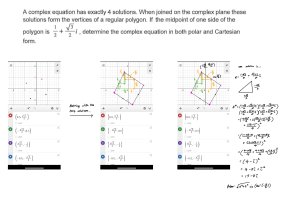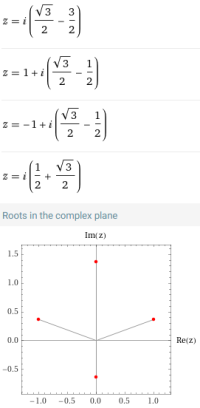A complex equation has exactly 4 solutions. When joined on the complex plane, these solutions form the vertices of a regular polygon. If the midpoint of one side of the polygon is 1/2 + √3/2 i, determine the complex equation in both polar and Cartesian form.
I have attached my working and diagrams with the full question.
My first step was to plot the midpoint. After that, I plotted the other 3 midpoints, adding or subtracting 1/2 and √3/2 from (0,0) accordingly as shown on my diagram. This is because the 4 solutions would be equidistant from each other, hence the midpoints would also be equidistant from each other.
I then found one solution by using Pythagoras’ theorem to construct a point which would be the same distance from two of the midpoints - (1/2,√3/2) and (-√3/2, 1/2).
Since this point was a solution of the overall complex equation which had 4 roots in total, I took the point to the power of 4 to find the overall equation. Though, I believe part of my Process is faulty as the answer cannot be converted into a polar form with an argument from a special triangle (this question is supposed to be doable without a calculator).
I have attached my working and diagrams with the full question.
My first step was to plot the midpoint. After that, I plotted the other 3 midpoints, adding or subtracting 1/2 and √3/2 from (0,0) accordingly as shown on my diagram. This is because the 4 solutions would be equidistant from each other, hence the midpoints would also be equidistant from each other.
I then found one solution by using Pythagoras’ theorem to construct a point which would be the same distance from two of the midpoints - (1/2,√3/2) and (-√3/2, 1/2).
Since this point was a solution of the overall complex equation which had 4 roots in total, I took the point to the power of 4 to find the overall equation. Though, I believe part of my Process is faulty as the answer cannot be converted into a polar form with an argument from a special triangle (this question is supposed to be doable without a calculator).


